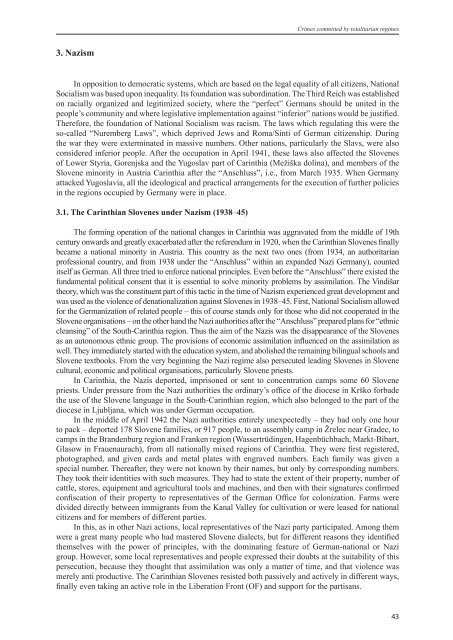crimes committed by totalitarian regimes - Ministrstvo za pravosodje
crimes committed by totalitarian regimes - Ministrstvo za pravosodje
crimes committed by totalitarian regimes - Ministrstvo za pravosodje
Create successful ePaper yourself
Turn your PDF publications into a flip-book with our unique Google optimized e-Paper software.
Crimes <strong>committed</strong> <strong>by</strong> <strong>totalitarian</strong> <strong>regimes</strong><br />
3. Nazism<br />
In opposition to democratic systems, which are based on the legal equality of all citizens, National<br />
Socialism was based upon inequality. Its foundation was subordination. The Third Reich was established<br />
on racially organized and legitimized society, where the “perfect” Germans should be united in the<br />
people’s community and where legislative implementation against “inferior” nations would be justified.<br />
Therefore, the foundation of National Socialism was racism. The laws which regulating this were the<br />
so-called “Nuremberg Laws”, which deprived Jews and Roma/Sinti of German citizenship. During<br />
the war they were exterminated in massive numbers. Other nations, particularly the Slavs, were also<br />
considered inferior people. After the occupation in April 1941, these laws also affected the Slovenes<br />
of Lower Styria, Gorenjska and the Yugoslav part of Carinthia (Mežiška dolina), and members of the<br />
Slovene minority in Austria Carinthia after the “Anschluss”, i.e., from March 1935. When Germany<br />
attacked Yugoslavia, all the ideological and practical arrangements for the execution of further policies<br />
in the regions occupied <strong>by</strong> Germany were in place.<br />
3.1. The Carinthian Slovenes under Nazism (1938–45)<br />
The forming operation of the national changes in Carinthia was aggravated from the middle of 19th<br />
century onwards and greatly exacerbated after the referendum in 1920, when the Carinthian Slovenes finally<br />
became a national minority in Austria. This country as the next two ones (from 1934, an authoritarian<br />
professional country, and from 1938 under the “Anschluss” within an expanded Nazi Germany), counted<br />
itself as German. All three tried to enforce national principles. Even before the “Anschluss” there existed the<br />
fundamental political consent that it is essential to solve minority problems <strong>by</strong> assimilation. The Vindišar<br />
theory, which was the constituent part of this tactic in the time of Nazism experienced great development and<br />
was used as the violence of denationali<strong>za</strong>tion against Slovenes in 1938–45. First, National Socialism allowed<br />
for the Germani<strong>za</strong>tion of related people – this of course stands only for those who did not cooperated in the<br />
Slovene organisations – on the other hand the Nazi authorities after the “Anschluss” prepared plans for “ethnic<br />
cleansing” of the South-Carinthia region. Thus the aim of the Nazis was the disappearance of the Slovenes<br />
as an autonomous ethnic group. The provisions of economic assimilation influenced on the assimilation as<br />
well. They immediately started with the education system, and abolished the remaining bilingual schools and<br />
Slovene textbooks. From the very beginning the Nazi regime also persecuted leading Slovenes in Slovene<br />
cultural, economic and political organisations, particularly Slovene priests.<br />
In Carinthia, the Nazis deported, imprisoned or sent to concentration camps some 60 Slovene<br />
priests. Under pressure from the Nazi authorities the ordinary’s office of the diocese in Krško forbade<br />
the use of the Slovene language in the South-Carinthian region, which also belonged to the part of the<br />
diocese in Ljubljana, which was under German occupation.<br />
In the middle of April 1942 the Nazi authorities entirely unexpectedly – they had only one hour<br />
to pack – deported 178 Slovene families, or 917 people, to an assembly camp in Žrelec near Gradec, to<br />
camps in the Brandenburg region and Franken region (Wassertrüdingen, Hagenbüchbach, Markt-Bibart,<br />
Glasow in Frauenaurach), from all nationally mixed regions of Carinthia. They were first registered,<br />
photographed, and given cards and metal plates with engraved numbers. Each family was given a<br />
special number. Thereafter, they were not known <strong>by</strong> their names, but only <strong>by</strong> corresponding numbers.<br />
They took their identities with such measures. They had to state the extent of their property, number of<br />
cattle, stores, equipment and agricultural tools and machines, and then with their signatures confirmed<br />
confiscation of their property to representatives of the German Office for coloni<strong>za</strong>tion. Farms were<br />
divided directly between immigrants from the Kanal Valley for cultivation or were leased for national<br />
citizens and for members of different parties.<br />
In this, as in other Nazi actions, local representatives of the Nazi party participated. Among them<br />
were a great many people who had mastered Slovene dialects, but for different reasons they identified<br />
themselves with the power of principles, with the dominating feature of German-national or Nazi<br />
group. However, some local representatives and people expressed their doubts at the suitability of this<br />
persecution, because they thought that assimilation was only a matter of time, and that violence was<br />
merely anti productive. The Carinthian Slovenes resisted both passively and actively in different ways,<br />
finally even taking an active role in the Liberation Front (OF) and support for the partisans.<br />
43




